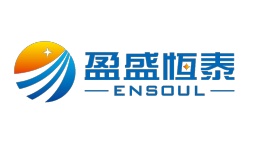方案详情文
智能文字提取功能测试中
POSTHARVEST BIOLOGY AND TECHNOLOGYHORTSCIENCE 52(9):1265-1270.2017. doi: 10.21273/HORTSCI12240-17 Effects of Low Oxygen and1-Methylcyclopropene on StorageDisorders of ‘Empire’Apples Jennifer R. DeEll and Geoffrey B. Lum Ontario Ministry of Agriculture, Food and Rural Affairs, P.O. Box 587,Simcoe, Ontario, Canada, N3Y 4N5 Additional index words. Malus Xdomestica, CO2 injury, flesh browning, 1-MCP, controlledatmosphere, dynamic CA, SafePod Abstract. The objective of this study was to investigate the effects of low-oxygen storageand 1-methylcyclopropene (1-MCP) on disorders and quality of‘Empire’apples. For 2years, Empire'apples were obtained from commercial orchards during their harvestingperiod. After cooling overnight at 3°C, the apples were treated with or without 1-MCP(1 uL·L-) for 24 hours and subsequently stored in controlled atmosphere (CA) with 2.5kPa O2(+2 kPa CO2) or 1.5 kPa O(+1.2kPa CO2) for 8 months at 1.5 and 3°C for thefirst and second year, respectively. In the second year, a third group of the‘Empire’apples was also held in respiratory quotient (RQ)-based dynamic CA storage (SafePod)that reached 0.6 kPa Oz (+0.5 kPa CO2), and half of these apples were treated with1-MCP(1uL·L-) for 24 hours at 3℃ upon removal after 8 months. All apples were thenevaluated for disorders and quality after 1, 7, or 14 days at room temperature (RT, 23 to24℃). Substantial external COz injury, flesh browning, and core browning (up to 38%incidence) developed in ‘Empire’stored in 2.5 and 1.5 kPa O, during both years of study.Storage in 1.5 kPa O2 reduced flesh browning in the first year and core browning duringthe second year in apples without 1-MCP, as compared to storage in 2.5 kPa Oz.1-MCP-treated apples stored in 2.5 or 1.5 kPa O, had higher overall incidence of disorders thansimilar fruit without 1-MCP. In contrast, there was negligible incidence (0% to 1%) ofthese disorders in‘Empire’apples held in 0.6 kPa O2, regardless of 1-MCP treatmentupon removal. Storage in 0.6 kPa O, also resulted in the greatest fruit firmness retentionwhile at RT for 14 days. This regime can provide flexibility to postpone 1-MCP treatmentuntil after storage, to prevent increased susceptibility to disorders during storage,without compromising fruit quality. However, results from the RQ-based dynamic CAwith 0.6 kPa O, were from a single season, and further research is needed to confirmthese observations. ‘Empire’is a major commercial applecultivar produced in the northeastern UnitedStates and Canada, as it appeals to consumersfor fresh quality attributes, texture, and flavorprofile. Despite its popularity, ‘Empire’ap-pacaco,an cles are sensitive to elevated CO2 and chill-ing conditions, making them susceptible tocertain physiological disorders in storage,including external CO2 injury and fleshbrowning (DeEll and Ehsani-Moghaddam,2012; Fawbush et al., 2008; Watkins andNock,2012). External CO2 injury is characterized byrough bronze lesions that are often partially ( Received for p ublication 16 June 2017.Accepted for publication 20 July 2017. ) ( This project was f unded i n part through GrowingForward 2 (GF2), a f e d eral-provincial-territorialinitiative. The Agricultural A daptation C o uncilassists in the delivery of GF2 in Ontario. ) ( The authors gratefully acknowledge the s u pport o f the Ontario A Applee G rowers, Norfolk Fr uitGrowers’ A ssociation, S torage C ontrol S y stemsInc., and AgroFresh I n c. during the course of this research, a s well as Lorie W alker f o r her technical assistance. ) ( 'Corresponding a uthor. E -mail: J ennifer.DeEll@ ontario.ca. ) sunken on the peel with well-defined edges(Fawbush et al., 2008; Meheriuk et al., 1994;Watkins et al., 1997). Development of exter-nal CO2 injury usually occurs within the earlystages of CA storage and it is more prevalentwith rapid establishment of elevated COlevels, especially if apples are not sufficientlycooled before storage (Burmeister and Dilley,1995; DeEll et al., 2016;Meheriuk et al., 1994;Watkins and Liu, 2010; Watkins et al., 1997).In most cases, symptoms ofexternal CO2 injuryprogress with minimal internal flesh browningor damage. Flesh browning, also known as internalbrowning, is characterized by diffuse brown-ing of the flesh tissue, and it is typically notvisible from the external surface (DeEll andEhsani-Moghaddam,2012; DeEll et al.,2007; Meheriuk et al., 1994; Watkins andLiu, 2010). The onset of flesh browning inapples is postulated to be associated with lowtemperatures during storage (Jung and Watkins,2011; Watkins and Liu,2010). Postharvest treatment with 1-MCP, aninhibitor of ethylene action, has been shownto improve quality characteristics of apples,including reduced ethylene production andrespiration, as well as improved firmness andacidity retention (DeEll etal.,2007; Watkins, 2007). Unfortunately,1-MCP can also exac-erbate the susceptibility of‘Empire'apples toexternal CO2 injury and flesh browningdisorders (DeEll and Ehsani-Moghaddam,2012; DeEll et al., 2003, 2005; Fawbushet al., 2008). Previous studies have reported the prac-tice of delaying CA storage to be beneficialfor reducing disorders in apples (DeEll andEhsani-Moghaddam, 2012; Watkins andNock, 2012). Delayed CA storage involvesdelaying the establishment of CA by holdingfruit in ambient air at low temperaturesbefore exposure to low O2 and elevatedCO2 (Argenta et al., 2000; de Castro et al.,2007). Delaying CA for 1 or2 months at 1Creduced external CO2 injury and flesh brown-ing disorders in ‘Empire’apples compared tofruit placed immediately into CA (DeEll andEhsani-Moghaddam, 2012).Similarly, delay-ing CA for 2 or 4 weeks at 0.5 ℃ reducedCO2-induced flesh browning in ‘Pink Lady’apples (de Castro et al., 2007). However,inconsistencies and year-to-year variation inthe effects of delayed CA establishment foralleviating certain storage disorders in appleshave also been documented (Argenta et al.,2000; DeEll and Ehsani-Moghaddam, 2012;DeEll et al., 2016; Watkins and Nock, 2012). In recent years, there has been a renewedinterest in low O2 storage of apples due to theadvent of dynamic CA in which fruit re-sponse to stress is monitored. The applicationof low O2 (<2 kPa) during storage has shownadvantages for maintaining apple qualitycharacteristics, including reduced ethyleneproduction and respiration, maintained fruitfirmness, sugars and acidity levels, anddelayed fruit senescence (Both et al., 2016;Thewes et al.,2015). Exposure to low O2 canalso alleviate superficial scald in certainsusceptible apple cultivars (Lumpkin et al.,2014; Pesis et al., 2007; Wang and Dilley,2000; Zanella, 2003). When apples are heldin standard CA (2-3 kPa O2), fruit aregenerally held in atmospheric conditionsgreater than their anaerobic compensationpoint, the point where fruit O2 consumptionand CO2 production are at minimal rates(Thewes et al., 2015; Yearsley et al., 1996).Consequently, fruit respiration and associ-ated metabolic processes are not at minimum,leading to potential fruit quality loss instandard CA storage. However, further re-duction of O2 levels during storage also raisesconcerns for increased low O2-related stressand injury (Wright et al., 2015). Fruit RQ, defined as the ratio of CO2production to O2 consumption, can be used toassess low O2-related stress in fruit and asa signal to adjust atmospheric compositionwithin storage systems (Gran and Beaudry,1993; Yearsley et al., 1996). By monitoringO2-related stress in real-time with adjust-ments of O2 partial pressures throughout thestorage period, the respiratory health ofapples under low O2 can be observed auton-omously. This is considered dynamic CAstorage, which involves the reduction of O2partial pressures to the lowest possible toler-ance level without inducing excess anaerobic metabolism affecting fruit quality and off-flavours associated with fermentation products(Bessemans et al., 2016; Thewes et al., 2015). Although the benefits of low O2 storageon apple quality are well-documented in theliterature (Bessemans et al., 2016; Kopcke,2015; Lumpkin et al., 2014; Rebeaud andGasser, 2015; Veltman et al.,2003; Zanella,2003), the response of a CO2 and chillingsensitive apple like ‘Empire’to low O2 levels(<2 kPa) in combination with 1-MCP is notunderstood.The objective of this study was toinvestigate the effects of low O2 and 1-MCPon storage disorders and fruit quality of‘Empire’apples. RQ-based dynamic CAstorage with 0.6 kPa O2 was also evaluatedin the second year of this study. Materials and Methods Plant material. ‘Empire’ apples wereharvested from two orchards on Sept. 27 in2013 and a single orchard on Sept. 29 in 2015located near Simcoe (Norfolk County),Ontario, Canada. There were 24 and 16 boxesof apples (~13 kg) harvested in 2013 and2015, respectively, with three box replicatesper treatment for each orchard, except for twobox replicates per treatment for fruit held inRQ-based dynamic CA storage (SafePodM,Storage Control Systems Inc., Sparta,MI) inthe second year. Each box contained fruitfrom several trees and from various locationswithin the trees. All apples were transportedwithin 1 h of harvest to the nearby applestorage research facility and cooled overnightat 3°C. Postharvest treatments. In the first year ofstudy, after cooling overnight at 3 ℃, half ofthe apples (12 boxes) were treated with 1-MCP(1 uL·L-) for 24 h. 1-MCP application wasmade using SmartFreshTM tablets (AgroFreshInc., Collegeville, PA) within an air-tighttreatment tent (Storage Control Systems Inc.,Sparta, MI) at 3 °C. Thereafter, three boxes ofEmpire’apples with and three boxes without1-MCP treatment from each orchard wereplaced into CA storage of either 2.5 kPa O2 +2 kPa CO2 (standard) or 1.5 kPa O2+1.2 kPaCO2 (low O2) at 1.5 C for 8 months. In the second year of study, after coolingovernight at 3°C, six boxes of apples weretreated with 1-MCP (1 uL·L-) for 24 h.Thereafter, three boxes of ‘Empire’appleswith and three boxes without 1-MCP treat-ment were placed into CA storage of either2.5 kPa O2+2 kPa CO2 or 1.5 kPa O2 +1.2kPa CO2 at 3 ℃ for 8 months. The fourremaining boxes of apples without 1-MCPtreatment were held in a novel RQ-baseddynamic CA storage regime at 3°C, in whichthe O2 was initially pulled down to 1.5 kPaand then gradually decreased to 0.6 kPa O2(+0.5 kPa CO2) within 2 to 3 months. After 8months of storage, half of the apples (twoboxes) from 0.6 kPa O2 were then treatedwith 1-MCP (1 uL.L) for 24 h at 3 °C. The CA storage system consisted of smallaluminum storage chambers (0.9 m’volume)fitted with a circulating fan system (StorageControl Systems Inc., Sparta, MI). Atmospheres were checked hourly and maintained within0.2 kPa of target values using an ICA 61/CGS610 CA Control System (International Con-trolled Atmosphere Ltd., Kent, UK), whichwas modified with flow controllers for theexperimental chambers (Storage ControlSystems Inc., Sparta, MI). The RQ-baseddynamic CA storage system consisted ofSafePodTM technology (Storage Control Sys-tems Inc., Sparta, MI), in which up to 80 kg offruit could be stored and RQ of the fruitmeasured. This was connected to the sameICA 61/CGS 610 CA Control System forstorage monitoring. Fruit quality and disorder evaluations.Initial fruit maturity at the time of harvestwas evaluated using 10-apple samples fromeach orchard. Internal ethylene concentrationwas determined by withdrawing a 3-mL gassample from the core of each fruit usinga syringe and injecting the gas sample intoa Varian CP-3380 gas chromatograph (VarianCanada Inc., Mississauga, Ontario, Canada)equipped with a 0.5-mL sample loop, flameionization detector, and 15 m×0.32 mm RestekRt-SPLOTIM capillary column (Chromato-graphic Specialties Inc., Brockville, Ontario,Canada). The injector, column, and detectortemperatures were 120, 35, and 225C,respectively. High-grade helium was usedas the carrier gas at a flow rate of0.37 mL·swith a typical run time of 1.5 min. Fruit firmness was determined on oppo-site sides of each apple after peel removal,using an electronic texture analyzer fittedwith an 11-mm tip (GUSS, South Africa).Thereafter, juice was extracted and collectedfrom composite samples of segments from allapples used for firmness testing. Titratableacidity (expressed as mg equivalents of malicacid per 100 mL of juice) was determined bytitrating a 2-mL juice sample (extracted fromcomposite samples of fragments from allapples used for firmness testing) with 0.1 NNaOH to an endpoint of pH 8.1 (as indicatedby phenolphthalein), whereas soluble solidsconcentration was determined on a juicesample using a digital refractometer [BRX-242 (Erma Inc., Japan) in 2013 and PR-32(Atago Co. Ltd., Japan) in 2015]. The starchindex was determined using a GenericStarch-Iodine Index Chart for Apples (Blan-pied and Silsby, 1992). Apples were cut inhalf at the equator, dipped in potassium-iodine solution and rated on a scale of 1 to8, where 1=100% starch staining and 8=nostarch. After removal from storage, fruit wereheld at RT (23 to 24C) and then evaluatedfor fruit quality and storage disorders after 1,7, or 14 d. Ten fruit per box replicate of eachtreatment were measured for internal ethyl-ene concentration, firmness, soluble solidsconcentration, and malic acid content. Theincidence of storage disorders, namely exter-nal CO2 injury, flesh browning, and corebrowning, were determined using all applesin each box replicate of each treatment (up to83 per box). Incidence was calculated asa percentage of fruit displaying the disorderregardless of severity. Statistical analyses. Data from each yearwere analyzed using Proc GLM and ProcGLIMMIX of the SAS program (Version 9.2;SAS Institute Inc., Cary,NC), incorporatinga split-plot experimental design. All datawere subjected to testing of normality andassumptions for analysis of variance and trans-formed for analysis when appropriate. Meanseparations were examined using Duncan’smultiple range test and only differencessignificant at P≤ 0.05 are discussed. Results and Discussion ‘Empire’apples were obtained during thecommercial harvest period, and fruit maturityat harvest time is presented in Table 1. In-ternal ethylene concentration and starch in-dex values were not significantly different forthe two orchards in 2013, and therefore, thesewere combined for poststorage analyses.There was a difference in fruit firmnessamong these two orchards, but firmness isnot an appropriate measure of maturity as ittends to be strongly influenced by orchardmanagement and growing conditions (DeEllet al.,2001). Starch index was higher in the2015 orchard compared with one of theorchards in 2013 (Table 1). There were nosignificant differences in internal ethyleneconcentration at harvest time, which is themajor fruit maturity indicator. There werealso no significant differences in solublesolids concentration and malic acid content.All apples were considered marketable, andno visible symptoms of disorders were pres-ent at harvest time. External CO2 injury, flesh browning, andcore browning developed in the apples duringboth years of study (Table 2). However, therewere no consistent effects of low O2 or1-MCP treatment ondisorder incidencethroughout both years. During the first year of study, there wereno significant effects of low O2 or 1-MCP onthe incidence of external CO injury. Incontrast, during the second year, the applica-tion of 1-MCP after harvest increased theincidence of external CO2 injury in ‘Empire’apples stored in both 2.5 and 1.5 kPa O2.Furthermore, 1-MCP-treated apples had lessexternal CO2 injury when held in 1.5 kPa O2than in 2.5 kPa O2. ‘Empire’apples stored in0.6 kPa O2 with or without 1-MCP treatmentupon removal had very little external CO2injury after 8 months of storage ‘Empire’is a CO2 sensitive apple cultivar,and exposure to elevated CO during theearly stages of storage can provoke the de-velopment of CO2 injuries (Fawbush et al.,2008; Watkins and Nock, 2012). Delayingestablishment of CA and elevated CO2 expo-sure has been reported to reduce the in-cidence of external CO2 injury in ‘Empire’apples (DeEll and Ehsani-Moghaddam,2012).Application of the antioxidant diphenylamine(DPA) also controls the development ofexternal CO2 injury (Argenta et al., 2002;Fawbush et al., 2008; Watkins et al., 1997),but the use of DPA on apples may soonbecome restricted due to regulatory issues. Table 1. Maturity indices of ‘Empire’apples at harvest. 2013Orchard 1 Internal ethylene concn (uLL-) Firmness (N) Soluble solids concn (%) Malic acid(mg) Starch index(1-8) 0.04 a 72.1 b 11.0 a 788a 3.8 ab Orchard 2 0.1 a 77.3 a 11.6a 885 a 2.8b 2015 6.5 a 79.2 a 9.8a 662 a 4.8 a Significance NS *** NS NS * ‘mg per 100 mL of juice. Based on the generic starch-iodine index chart for apples (Blanpied and Silsby, 1992). Means within the same column with the same letter are not significantly different at P<0.05. *, ***Significant at P<0.05 or P<0.001, respectively. Ns = nonsignificant. Table 2. Storage disorders of ‘Empire’apples treated with or without 1-MCP (1uL·L-) for 24 h and then held in 2.5 kPa O2 +2 kPa CO2 or 1.5 kPa O2 +1.2 kPaCO2 at 1.5℃ (Year 1) or 3℃ (Year 2) for 8 months, plus 7 d(Year 1) or 14d (Year2) at room temperature (23 to 24°C). Year 2 also included storage in 0.6kPa O2 +0.5 kPa CO2 for 8 months, followed by treatment with or without 1-MCP(1 uLL-) for 24 h. External CO2 injury (%) Flesh browning (%) Core browning (%) Year 1 2.5 kPa O, No 1-MCP 12.7 a 19.0a 23.2c +1-MCP at harvest 20.5a 11.2 ab 32.3 ab 1.5 kPa O2 No 1-MCP 24.6 a 8.9b 24.6 bc +1-MCP at harvest 22.5 a 5.8 b 38.3 a Significance? NS ** ** Year 2 2.5 kPaO No 1-MCP 3.6c 1.0b 19.5 a +1-MCP at harvest 24.8a 8.8a 21.4a 1.5 kPa O, No 1-MCP 2.2c 1.5 b 5.2b +1-MCP at harvest 12.5 b 12.2a 17.6a 0.6 kPa O, No 1-MCP 0c 0.5 b 0.5b +1-MCP at opening 1.1c 0.6 b 0b **** **** **** Significance Means within the same column with the same letter are not significantly different at P<0.05. **,****Significant at P <0.01 orP<0.0001, respectively. Each value represents the average of 204 and 249 apples in Year 1 and 2, respectively, except each value from 0.6 kPa O2 represents the average of148 apples.1-MCP=1-Methylcyclopropene; Ns = nonsignificant. In the current study, neither delayed CA norDPA were used to increase the likelihood ofdeveloping storage disorders. Postharvest 1-MCP treatment has beenshown to increase the susceptibility of ‘Em-pire’apples to external CO2 injury (DeEllet al., 2003,2005; Fawbush et al.,2008), andthis was observed in the second year of thecurrent study. Previous studies have shownthat the effects of 1-MCP on external CO,injury can become less prominent when thereis a high incidence of external CO2 injury, aswell as be influenced by year-to-year andorchard-to-orchard variations (DeEll andEhsani-Moghaddam, 2012; Deyman et al.,2014). Treatment with 1-MCP had negligibleeffects on flesh browning in the first year,whereas apples treated with 1-MCP afterharvest and then held in 2.5 or 1.5 kPa O,displayed higher incidence of flesh browningthan similar non-1-MCP-treated fruit in thesecond year (Table 2). It has been previouslyshown that 1-MCP treatment can exacerbateflesh browning in ‘Empire’apples and moreso at warmer storage temperatures (Jung andWatkins, 2011; Lee et al., 2012). In thecurrent study, apples were stored at 1.5 and3C in the first and second year, respectively.Therefore, the warmer temperature may havebeen a factor in 1-MCP-treated apples having higher incidence of fleshing browning com-pared with those not treated only in thesecond year. In the first year of study, non-1-MCP-treated ‘Empire’ had less flesh browningwhen held in 1.5 kPa O2 than in 2.5 kPa O2(Table 2). However, this effect was notpresent in the second year. ‘Empire’ applesstored in 0.6 kPa O2 with or without 1-MCPtreatment upon removal had very little fleshbrowning after 8 months of storage, and theincidence was not significantly different fromfruit without 1-MCP and stored in 2.5 or 1.5kPa O2. Similarly, Thewes et al. (2015) foundno difference in the incidence of flesh break-down (browning) in non-1-MCP-treated‘Royal Gala’and ‘Galaxy’apples stored in1.2 or 0.4 kPa O2. The onset of flesh browningin ‘Empire’apples can also be influenced byfruit maturity at harvest (Ehsani-Moghaddamand DeEll, 2009), as well as demonstrateyear-to-year and orchard-to-orchard variation(DeEll and Ehsani-Moghaddam, 2012; Deymanet al., 2014; Jung and Watkins,2011). Core browning was more prevalent in‘Empire'apples with 1-MCP treatment afterharvest than nontreated fruit in the first year,regardless of O2 level (Table 2). In the sec-ond year of study, 1-MCP-treated ‘Empire’apples had higher incidence of core browningthan nontreated fruit held in 1.5 kPa O2, while there was no significant difference in appleswith or without 1-MCP stored in 2.5 kPa O.Previous work showed that 1-MCP treatmentat harvest resulted in less core browning in‘Empire’apples held in ambient air at 0 to1°C for 6 months, whereas there was noeffect on core browning when stored in CA(2.5kPa O2+2.5 kPa CO2) at 2°℃ for 9 or 12months (DeEll et al., 2007). The efficacy of1-MCP on reducing core browning in applestypically declines with apples that are ofadvanced maturity at harvest (DeEll et al.,2007; Watkins et al., 2000), which may haveinfluenced the above results. ‘Empire’apples stored in 0.6 kPa O2 withor without 1-MCP treatment upon removalhad very little core browning after 8 monthsof storage and the incidence was not signif-icantly different from fruit not treated with1-MCP and stored in 1.5 kPa O2. Overall, low O2 reduced flesh browning inthe first year and core browning during thesecond year in ‘Empire’apples without1-MCP (Table2). Otherwise low O2 had nosignificant effects on storage disorders and itnever increased the incidence. Storagedisorders in non-1-MCP-treated fruit hadsimilar low incidence in all O2 regimesutilized in the second year, except for corebrowning in 2.5 kPa O2. There was minimalincidence of disorders (0% to 1.1%) in apples held in 0.6 kPa O2, regardless of 1-MCPtreatment upon removal. It is an importantdifference that apples stored in 0.6 kPa O2had 1-MCP applied after storage rather thanat harvest time like for the fruit held in 2.5 or1.5 kPa O2. Therefore, 1-MCP was unable toinfluence disorder development in ‘Empire’apples during storage in 0.6 kPa O2. 1-MCPtreatment at harvest resulted in higher in-cidence of external CO2 injury and fleshbrowning in apples held in 2.5 or 1.5 kPaO for at least one year of study and increasedcore browning in fruit stored in 1.5 kPa O2 forboth years (Table2). It has been previouslypostulated that 1-MCP delays ripening andmaintains apples in the “at harvest” state,which would consequently extend the periodof fruit sensitivity to stress during the earlystages of storage and ultimately result inmore storage disorders (Fawbush et al.,2008; Jung and Watkins, 2011). The exactbiochemical events for 1-MCP to increasefruit susceptibility to certain disorders are notwell understood. The effect of low O2 on internal ethyleneconcentration was noticeable 1 d after re-moval from storage, as ‘Empire’ appleswithout 1-MCP had lower internal ethylenewith lower O2 levels (Tables 3 and 4).However, this effect was no longer presentafter 7 and 14 d at RT. There was also nosignificant effect of low O2 on internalethylene concentration in fruit treated with1-MCP at harvest time. As expected, 1-MCP reduced internalethylene in ‘Empire’apples, often regardlessof Olevel and shelf life duration at RT (Tables 3and 4). Lower ethylene production in applestreated with 1-MCP treatment is in agreementwith previous reports (Argenta et al., 2000;DeEll et al., 2005; Fawbush et al., 2008; Jungand Watkins, 2011; Watkins and Nock, 2012). It is of particular interest that applestreated with 1-MCP upon removal fromstorage in 0.6 kPa O2 had lower internalethylene concentration than those not treatedonly 1 d later at RT (Table 4). This effect was also observed after 7 d at RT, but was thenlost after 14 d. Ethylene production in apples has beenpreviously shown to decrease with lower O,levels in storage, as ‘Royal Gala’and ‘Gal-axy’apples held in 0.4 kPa O2 at 1C hada lower rate of ethylene production thansimilar fruit in 1.2 kPa O2 (Thewes et al.,2015). Similarly, ‘Scarlett Spur Red Delicious’apples in 0.3 kPa O2 had lower internalethylene content than fruit held in 1.6 kPaO2 after 8 months of storage plus 7 dat20℃(Lumpkin et al., 2014). After removal from storage in 2.5 kPa O2plus 1, 7, and 14 d at RT, fruit firmness wasgreater in ‘Empire’ apples treated with1-MCP than those not treated (Tables 3 and 4).Similar effects of higher firmness in 1-MCP-treated fruit stored in 1.5 or 0.6 kPa O2 werenot found until 7 or 14 d at RT, respectively.In the first year of study, apples without1-MCP and stored in 1.5 kPa O2 had compa-rable firmness after 7 d at RT to those storedin 2.5 kPa O2 plus only 1 d at RT. In thesecond year, apples without 1-MCP andstored in 0.6 kPa O2 had comparable firmnessafter 14 d at RT to those treated with 1-MCPand stored in 1.5 or 2.5 kPa O2. Furthermore,‘Empire’apples from 0.6 kPa O2 and treatedwith 1-MCP were firmer than all othertreatments after 14 d at RT. The enhanced firmness retention found inthis study with lowering O2 in the atmosphereduring storage is consistent with previousreports (Kopcke, 2015;Rebeaud and Gasser,2015; Thewes et al., 2015; Veltman et al.,2003). For example, Royal Gala’and ‘Gal-axy'apples from 0.4 kPa O2 had greater fleshfirmness than fruit from 1.2 kPa O2 after 9 monthsof storage plus 7 d shelf life (Thewes et al., 2015).These apples in 0.4 kPa O2 also showed reducedactivity of1-aminocyclopropane-1-carboxylate(ACC) oxidase, an ethylene biosynthesis enzyme.Ethylene reduction can affect ethylene-regulatedgenes and encoding enzymes associatedwith cell wall degradation and modifications(Bennett and Labavitch, 2008), thus leading to enhanced firmness retention. The effect of1-MCP for retaining firmness in apples hasalso been well documented (DeEll andEhsani-Moghaddam, 2012; DeEll et al.,2007; Jung and Watkins, 2011; Watkinset al., 2000). There were no significant effects of lowO, or 1-MCP on soluble solids concentra-tion in ‘Empire’apples during both yearsof study(Tables 3 and 4). ‘Empire’appleswith 1-MCP had slightly higher malic acidcontent than untreated fruit in the secondyear, specifically in those from 2.5 or 1.5kPa O2 plus 14 dat RT (Table 4). Previousreports also showed inconsistent or noeffects of 1-MCP on soluble solids con-centration in ‘Empire’apples (DeEll et al.,2007;DeEll and Ehsani-Moghaddam, 2012).The marginal changes in soluble solids andmalic acid in this study suggest that sugarand organic acid metabolism were not read-ily altered by the low O2 levels duringstorage. In summary, the results from this studysuggest that lowering the O2 levels instorage rooms can have varying beneficialeffects on storage disorders and fruit qualityin‘Empire’ apples. 1-MCP treatment atharvest provided additional fruit firmnessretention and reduced internal ethylene butit also tended to increase storage disorders.The use of RQ-based dynamic CA storagewithi 0.6 kPa O2 resulted in negligiblestorage disorders and greater fruit firmnessretention. This could provide flexibility topostpone 1-MCP treatment until after stor-age, to prevent increased susceptibility todisorders during storage without compromis-ing fruit quality, which would in turn allowproducers to decide the marketing avenue(i.e., conventional vs. organic) throughoutthe storage season instead of at harvest time.However, results from RQ-based dynamicCA with 0.6 kPa O, and 1-MCP treatmentafter storage were from a single season, andfurther research is needed to confirm theseobservations. Table 3. Quality of ‘Empire’apples treated with or without 1-MCP (1 uL·L-) for 24 h and then held in 2.5 kPa O2+2 kPa CO2 or 1.5 kPa O2 + 1.2 kPa CO2 at1.5°℃ for 8 months,plus 1 or 7 d at room temperature (RT, 23 to 24℃), in Year 1. Internal ethylene concn (uLL-) Firmness (N) Soluble solids concn(%) Malic acid(mg) l d at RT 2.5 kPa O, No 1-MCP 28.9c 65.3 d 11.6 a 420 ab +1-MCP at harvest 0.3 d 74.3 a 11.4 a 458 a 1.5 kPa O2 No 1-MCP 3.9d 72.0 bc 11.8 a 407 ab +1-MCP at harvest 0.1 d 72.9 ab 11.8 a 421 ab 7 d at RT 2.5 kPa O2 No 1-MCP 291.6 b 57.2 e 11.8 a 365 bc +1-MCP at harvest 28.3 c 70.2c 11.5 a 407ab 1.5kPa O, No 1-MCP 315.8 a 65.7d 11.5 a 333c +1-MCP at harvest 22.4 cd 73.4 ab 11.5 a 393 abc Significance **** **** NS ** mg per 100 mL of juice. Means within the same column with the same letter are not significantly different at P<0.05. **, ****Significant at P <0.01, or P <0.0001, respectively. Each value represents the average of 30 apples. Table 4. Quality of ‘Empire’apples treated with or without 1-MCP (1uL·L) for 24 h and then held in 2.5 kPa O2+2kPa CO2 or 1.5 kPa O2+1.2kPa CO at 3℃for 8 months, or stored in 0.6 kPa O2+0.5 kPa CO2 for 8 months followed by treatment with or without 1-MCP(1 uLL-) for 24 h, plus 1, 7, or 14 d at roomtemperature (RT, 23 to 24 °C), in Year 2. mg per 100 mL of juice. Means within the same column at a given time with the same letter are not significantly different at P<0.05. *, **, ****Significant at P<0.05,P<0.01, or P <0.0001,respectively. Each value represents the average of 30 apples for 2.5 and 1.5 kPa O2 or 20 apples for 0.6 kPa O2. Literature Cited ( Argenta, L., X . F an, and J . M attheis. 2 0 00. Delay-ing establishment of controlled a tmosphere orCO2 exposure reduces ‘Fuji’apple CO2 injurywithout excessive fruit quality loss. Postharvest Biol. Technol.20:221 - 229. ) ( Argenta, L .C. , X . F an, a nd J . P. M attheis. 2 002.Responses of ‘Fuji’ apples to short and longduration e xposure to elevated CO2 concentra-tion. Postharvest Biol. Technol. 24:13-24. ) ( Bennett, A.B. and J.M. Labavitch. 2008. Ethylene and ripening-regulated expression and fu n ctionof fruit cell wall modifying p r oteins. Plant Sci.175:130-1 3 6. ) ( Bessemans, N . , P. V erboven, B.E. V e rlinden, andB.M. Nicolai. 2016. A novel type of dynamiccontrolled atmosphere storage based on t herespiratory quotien t (RQ-DCA). Postharvest Biol. Technol. 115:91- 1 02. ) ( Blanpied, G.D. and K.J. S ilsby. 1992. P redicting h arvest date w indows fo r apples. Inform. Bul. .221. Cornell Coop. E xt. ) ( Both, V., F.R. Thewes, A. B rackmann, D . D.F.Ferreira, E.P . Pavanello , and R. .Wagner. 2016. E ffect of low oxygen conditioning andultralow oxygen storage on the volatile profile,ethylene p roduction a nd r e spiration r ate of ‘Royal Gala’apples. Sci. Hort. 209:156 - 164. ) ( Burmeister,D.M . and D.R.Dilley. 19 9 5. A ‘s c ald-like’ c ontrolled atmosphere storage disorder of ) ( Empire apples - a chilling injury induced byCO2.Postharvest Biol. Technol. 6:1-7. ) ( de C astro, E ., B . B iasi, E. Mitcham, S. Tustin, D. T anner, and J. Jobling. 2007. Carbon dioxideinduced flesh browning in Pink Lady apples. J. Amer. Soc. Hort. S ci. 132:713-719. ) ( DeEll, J.R., J . T . Ayres, and D.P . Murr. 2007. 1-Methylcyclopropene influences ‘Empire ’ and‘Delicious’ apple q uality d uring long-termcommercial s torage. HortTechnology 17:4651. ) ( DeEll, J.R., S. Khanizadeh, F . S aad, and D . C.Feree. 2 001. F a ctors affecting apple fru i t firm- ness-a review. J. Amer. P omol.Soc. 55:8-27. ) ( DeEll, J.R . and B . E hsani-Moghaddam. 2012. Delayed controlled a tmosphere s t orage affectsstorage disorders of ‘Empire’apples. Posthar- vest Biol.Technol. 67:167-171. ) ( DeEll,J.R., G.B. Lum, and B. Ehsani-Moghaddam. 2 016.Elevated carbon di o xide in storage rooms p rior to establishment of controlled atmosphere affects apple f ruit q uality. P ostharvest B i ol.Technol. 118:11 - 16. ) ( DeEll, J .R., D.P. Murr, R. M ueller, L . W iley, and M.D. P orteous . 2005. I nfluence of 1 -methylcyclopropene (1-MCP), d i phenylamine(DPA), and CO2 concentration during storageon ‘Empire’ap p le quality. Po s tharvest Bi o l. T echnol.38:1-8. ) ( DeEll,J.R., D.P. M urr, L. W iley, and M.D. Porteous. 2003. 1 -Methylcyclopropene (1-MCP) in c reases ) ( CO2 i n jury in a pples. Acta H ort. 6 00:227-280. ) ( D eyman, K.L., G . C h iu, J . Liu, C.J. Brikis, C.P. T robacher, J .R. D eEll, B .J. S help, and G.G.Bozzo. 2 014. E ffects of elevated CO a nd 1 -methylcyclopropene on s t orage-related dis-orders of Ontario-grown‘Empire’apples. Can. J. Plant Sci . 94:857 - 865 ) ( E hsani-Moghaddam, B. and J. D e Ell. 2009. Cor-relation and p ath-coefficient a nalyses of ripen-ing attributes and storage d isorders in ‘Ambrosia’a n d ‘ E mpire’ap p les. Postharvest Biol. Technol. 51:168-173. ) Fawbush, F., J.F. Nock, and C.B. Watkins. 2008. External carbon dioxide injury and 1-methylcyclopropene (1-MCP) in the ‘Em- pire’apple. Postharvest Biol. Technol. 48:92-98. Gran, C.D. and R.M. Beaudry. 1993. Determination of the low oxygen limit for several commercial apple cultivars by respiratory quotient break- point. Postharvest Biol. Technol.3:259-267. ( Jung,S.K. and C.B. Watkins. 201 1 . Involvement ofethylene in browning development o f c o n-trolled atmosphere-stored‘Empire’apple fruit. P ostharvest Biol. Technol. 59:219-226. ) ( Kopcke, D . 2015.1-Methylcyclopropene (1-MCP)and dynamic c o ntrolled a tmosphere ( DCA)applications under elevated storage tempera-tures: Effects on f ruit q uality o f ‘Elstar’,‘Jonagold’and ‘Gloster’apples (Malus domes-tica Borkh.). Eur. J. Hort. S ci. 80:25-32. ) ( Lee,J.,L. Cheng, D.R. Rudell, and C.B. Watkins. 2012. Antioxidant metabolism of 1-methylcyclopropene( 1 -MCP) treated ‘Empire’apples d uring con-trolled atmosphere s torage. P ostharvest B iol. T echnol.65:79-91. ) ( Lumpkin, C., J .K. F ellman, D.R. Rudell, and J . M attheis. 2 014. ‘S carlett Spur R e d De l icious’apple volatile production accompanying phys-iological disorder development during low p O 2controlled atmosphere storage. J . Agr. Food Chem. 62:1741-1754. ) Meheriuk, M., R.K. Prange,P.D. Lidster, and S.W.Porritt. 1994.Postharvest disorders of applesand pears. Agr. and Agri-Food Canada Publ.1737/E. ( Pesis, E., R. B en-Arie, O. F eygenberg, A. L ichter, O. Gadiyeva, I . Antiofyev, and T .Uryupina. 2 007. A simple pretreatment withlow O2 to alleviate s uperficial scald inGranny Smith a pples. J. Sci. Food A gr.87:1836-1844. ) ( R ebeaud, S.G. and F . Gasser. 2015. Fruit q ualityas affecte d by 1-MCP t reatment and DCA storage - a comparison o f the two methods. Eur. J. Hort . Sci.80:18-24. ) ( Thewes, F.R., V. Both, A. Brackmann, A. W eber, and R .D.O. Anese. 2015. D y namic co n trolled a t mo-sphere and ultralow oxygen storage on‘Gala’mu-tants quality maintenance. Food Chem. 1 88:62-7 0 . ) ( Veltman, R .H., J.A. Verschoor, and J.H. Ruijschvan D ugteren. 2003. Dynamic control system(DCS) for apples (Malus d omestica Borkh. cv‘Elstar’) : Optimal q uality through storage b ased o n product r e sponse. Postharvest Biol. Technol. 27:79-86. ) ( Wang,Z. and D.R. Dilley.2000. Initial low oxygen stress controls superficial s c ald of apples. Post- h arvest Biol. Technol. 18:201-213. ) ( Watkins, C.B. 2007. The e ffect of 1-MCP on thedevelopment of physiological s t orage d i sordersin horticultural crops. Stewart Postharvest Rev.2:11-14. ) ( Watkins, C.B. a nd F .W. L i u. 2010. Temperatureand carbon d i oxide interactions on quality ofcontrolled atmosphere-stored‘Empire’a p ples.HortScience 45:1708-1712. ) ( Watkins, C.B. a nd J .F. N ock. 2 012. R a pid 1-methylcyclopropene (1-MCP) treatment and delayed c ontrolled atmosphere storage of ap- ples. Postharvest Biol . Technol. 69:24-31. ) ( Watkins, C .B., J.F. Nock, and B.D. Whitaker. 2000. Responses of early, mid a nd late s eason a pple cultivars to postharvest application of 1-methyl-cyclopropene (1-MCP) under air and controlledstorage c onditions. P ostharvest B iol. T echnol.19:17 - 32. ) Watkins, C.B., K.J. Silsby, and M.C. Goffinet. 1997. Controlled atmosphere and antioxidant effects on external CO2 injury of‘Empire’ apples. HortScience 32:1242-1246. Wright, A.H., J.M. DeLong, J. Arul, and R.K. Prange. 2015.The trend toward lower oxygen levels during apple (Malus × domestica Borkh) storage-A review. J. Hort. Sci. Biotechnol. 90:1-13. Yearsley, C.W., N.H. Banks, S. Ganesh, and D.J.Cleland. 1996. Determination of lower oxygenlimits for apple fruit. Postharvest Biol.Technol.8:95-109. ( Zanella, A. 2003. C ontrol of apple superficialscald and ripening-a comparison between 1-methylcyclopropene and diphenylamine p ostharvest t reatments, i nitial low oxygen stress and ultra low oxygen storage. P ost-harvest Biol. Technol.27:69-78. ) oRTSCIENCE VoL. SEPTEMBER Abstract. The objective of this study was to investigate the effects of low-oxygen storage and 1-methylcyclopropene (1-MCP) on disorders and quality of ‘Empire’ apples. For 2 years, ‘Empire’ apples were obtained from commercial orchards during their harvesting period. After cooling overnight at 3 8C, the apples were treated with or without 1-MCP (1 mL·LL1) for 24 hours and subsequently stored in controlled atmosphere (CA) with 2.5kPa O2 (+2 kPa CO2) or 1.5 kPa O2 (+1.2 kPa CO2) for 8 months at 1.5 and 3 8C for the first and second year, respectively. In the second year, a third group of the ‘Empire’ apples was also held in respiratory quotient (RQ)-based dynamic CA storage (SafePod) that reached 0.6 kPa O2 (+0.5 kPa CO2), and half of these apples were treated with 1-MCP (1mL·LL1) for 24 hours at 3 8C upon removal after 8 months. All apples were thenevaluated for disorders and quality after 1, 7, or 14 days at room temperature (RT, 23 to 24 8C). Substantial external CO2 injury, flesh browning, and core browning (up to 38% incidence) developed in ‘Empire’ stored in 2.5 and 1.5 kPa O2 during both years of study. Storage in 1.5 kPa O2 reduced flesh browning in the first year and core browning during the second year in apples without 1-MCP, as compared to storage in 2.5 kPa O2. 1-MCPtreatedapples stored in 2.5 or 1.5 kPa O2 had higher overall incidence of disorders than similar fruit without 1-MCP. In contrast, there was negligible incidence (0% to 1%) of these disorders in ‘Empire’ apples held in 0.6 kPa O2, regardless of 1-MCP treatment upon removal. Storage in 0.6 kPa O2 also resulted in the greatest fruit firmness retention while at RT for 14 days. This regime can provide flexibility to postpone 1-MCP treatmentuntil after storage, to prevent increased susceptibility to disorders during storage, without compromising fruit quality. However, results from the RQ-based dynamic CA with 0.6 kPa O2 were from a single season, and further research is needed to confirm these observations.
关闭-
1/6
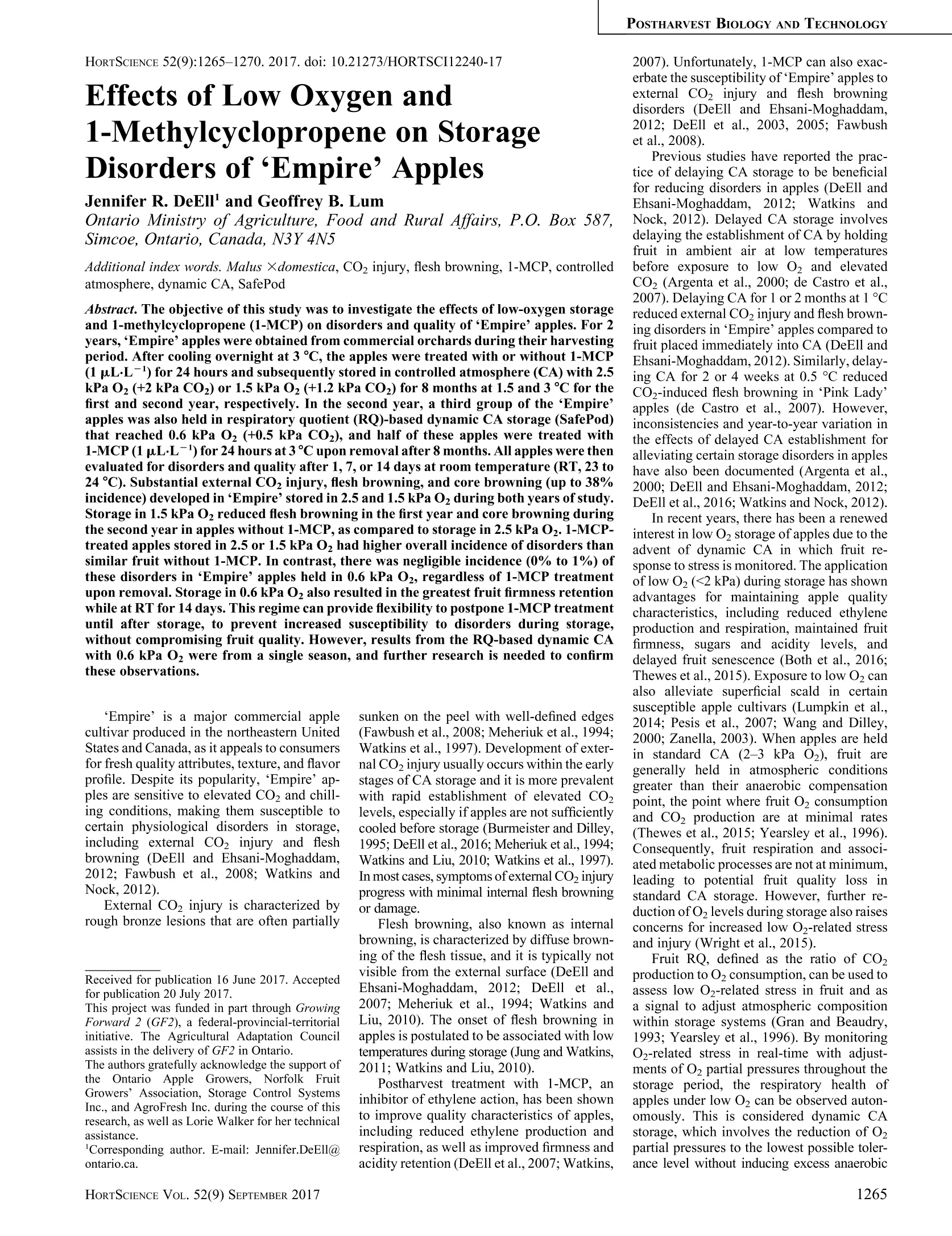
-
2/6
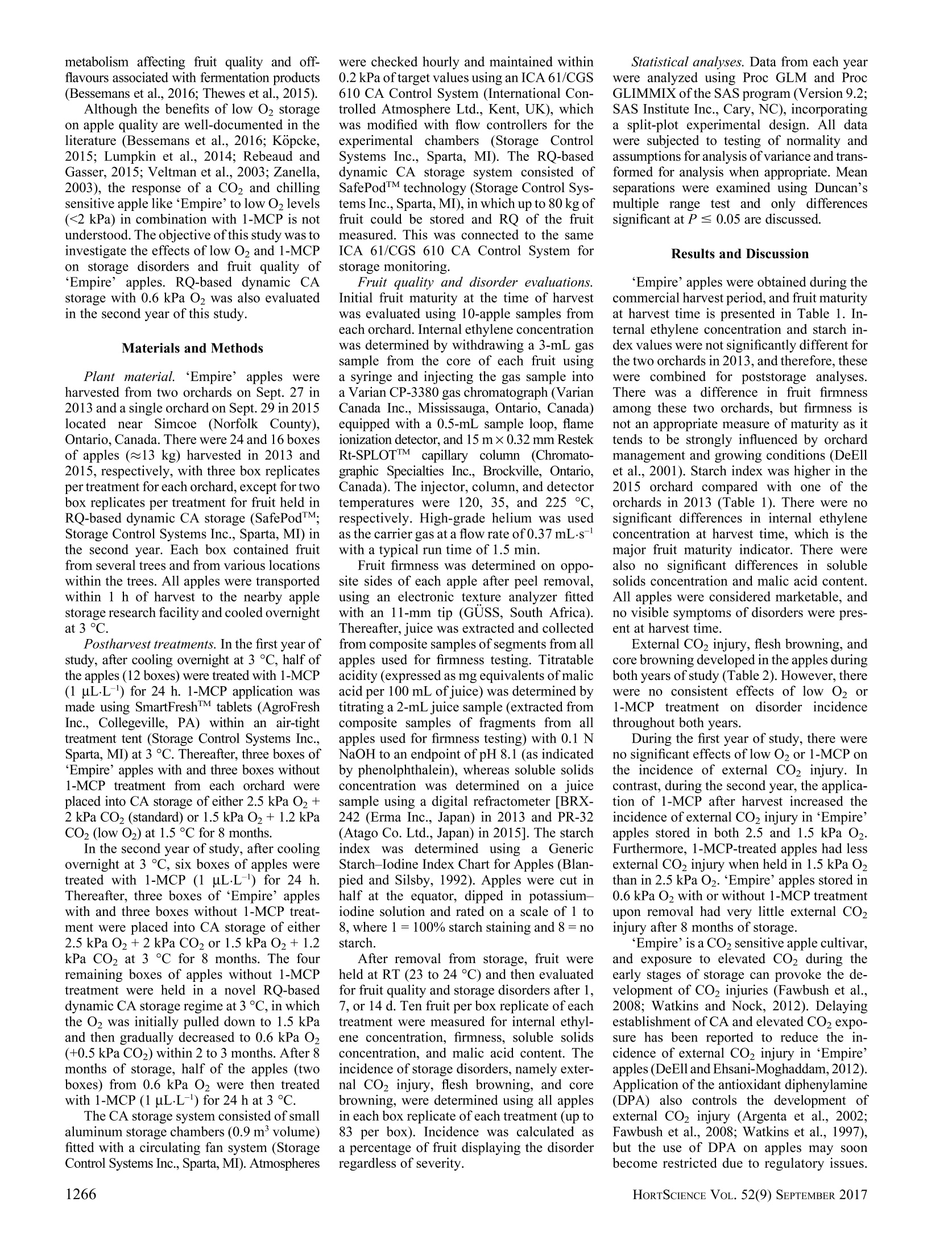
还剩4页未读,是否继续阅读?
继续免费阅读全文产品配置单
图拉扬科技有限公司为您提供《苹果中硬度、糖酸度、叶绿素A检测方案(光合仪)》,该方案主要用于其他水果制品中理化分析检测,参考标准《暂无》,《苹果中硬度、糖酸度、叶绿素A检测方案(光合仪)》用到的仪器有Safepod DCA 气调保鲜系统。
我要纠错
推荐专场
相关方案


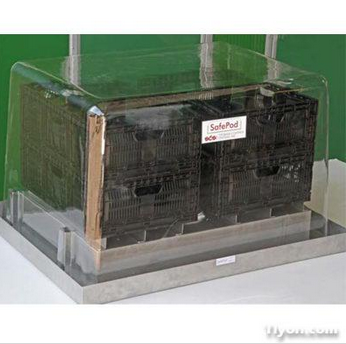
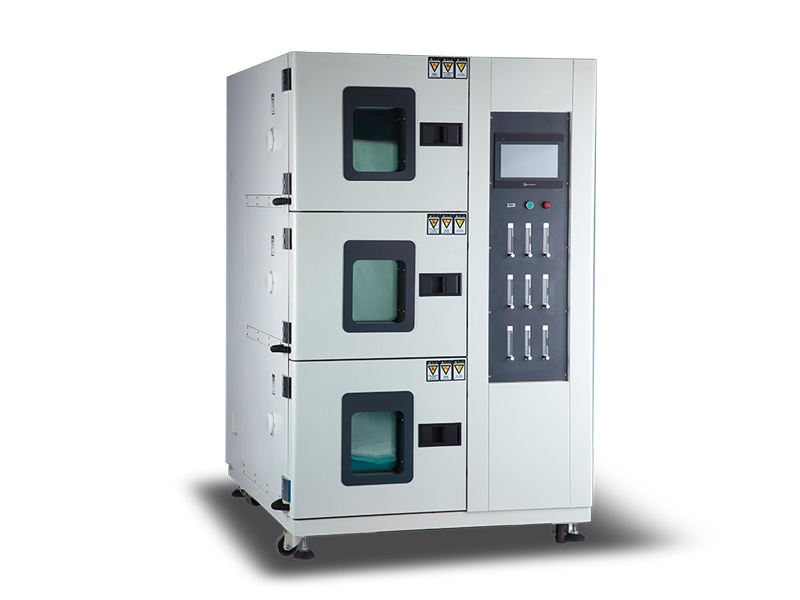
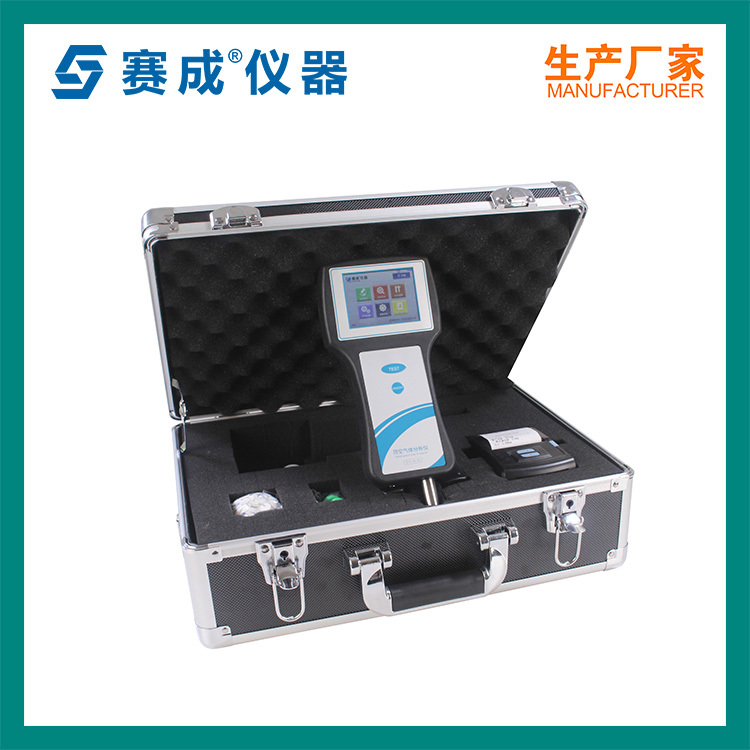
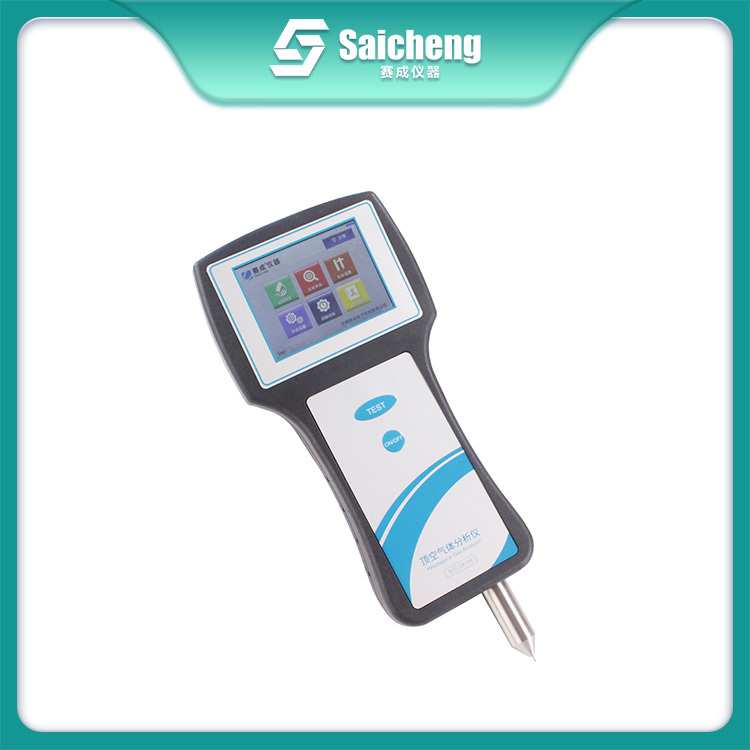
 咨询
咨询

